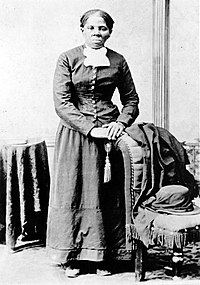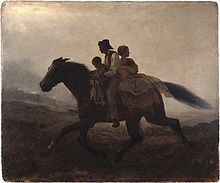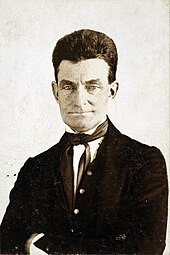地下鐵路 (秘密結社)
此條目翻譯品質不佳。 (2015年3月25日) |

| 奴隸制度 |
|---|
 |
地下鐵路(英語:Underground Railroad)是十九世紀美國秘密路線網絡和避難所,旨在幫助非裔奴隸逃往自由州和加拿大,得到了廢奴主義者及同情者的支持[1]。這一詞彙也用於指代幫助奴隸逃亡的廢奴主義者,他們包括白人、黑人、自由人和奴隸[2]。部分逃亡路線甚至延伸至墨西哥或海外[3]。地下鐵路的最南端達到西班牙屬地佛羅里達,並一直持續運作,直至1861年南北戰爭爆發[4]。該網絡起源於19世紀初,並在1850年至1860年間達到頂峰。[5]。據估算,至1850年已有約10萬名奴隸通過這條「鐵路」獲得自由[5]。
英屬北美(即今日的加拿大)禁止蓄奴,因而成為許多奴隸嚮往的目的地。延綿的邊界線為逃亡奴隸提供了不少便利。大多數逃至加拿大的前奴隸定居在安大略。據統計,在20年間,通過這一網絡逃往加拿大的奴隸超過30,000人[6],而美國人口普查的數據僅記錄了6,000人[7]。許多逃亡者的故事被費城的廢奴主義者威廉·斯蒂爾記錄在1872年出版的《地下鐵路記錄》中。
政治背景
[編輯]
在地下鐵路活動的高峰期,每年約有1,000名奴隸成功從蓄奴州逃離(法院記錄的逃亡案件超過5,000起),但這一數字相較於奴役人口的自然增長仍然很低。儘管逃亡對經濟影響有限,但對奴隸主的心理衝擊巨大。《1793年逃亡奴隸通緝法》要求各州協助追捕逃亡奴隸,然而自由州的公民和政府多選擇忽視,從而助長了地下鐵路的活躍。
在南方政客的推動下,美國國會在美墨戰爭後通過了《1850年妥協案》,使《1850年逃亡奴隸通緝法》更加嚴苛。妥協案表面上是為解決區域分歧,但實際上要求自由州官員協助奴隸獵人追捕逃亡奴隸,並允許獵人攜帶武器執行任務[8]。由於認定某人為奴隸的門檻極低,奴隸獵人還會綁架自由黑人,尤其是兒童[9]。南方政客常常誇大逃亡奴隸的數量,並指責北方干涉南方的財產權。[10]法案剝奪了嫌疑奴隸在法庭自辯的權利,使他們難以證明自身自由身份,賄賂也因此泛濫[11],法官若判定嫌疑人為奴隸可獲得更高報酬(10美元),反之則僅為5美元。許多原本中立的北方人因此被迫捲入奴隸制之爭。南北戰爭期間,聯邦政府將此視為戰爭的關鍵原因之一[12],而北方各州對逃亡奴隸通緝法的漠視則成為南方退出聯邦的主要理由之一[13]。
歷史
[編輯]結構
[編輯]

「地下鐵路」並非字面意義上的地下通道或鐵路。「地下」象徵隱秘的反抗運動,而「鐵路」則是一種隱晦的交流暗號[15]。該網絡包含會面地點、秘密路徑、運輸方式、避難所及支持廢奴運動的同情者。參與者通常組成小型獨立組織,以增強保密性,因為每人只掌握附近的若干會面「車站」位置,對整個網絡全貌知之甚少。逃亡奴隸沿着路線,從一個「車站」前往下一個,以北上求自由。鐵路的「售票員」來自不同背景,包括自由黑人、白人廢奴主義者、曾逃亡或被解放的前奴隸、以及美國原住民。教會的神職人員和信徒也積極參與,特別是貴格會、公理會、衛斯理會、改革長老會等基督教派,另有循道宗和浸禮宗等主流派系支持。若無自由黑人的幫助,逃亡奴隸幾乎無法順利避開追捕並獲得自由[16]。
路徑
[編輯]
為了降低被滲透的風險,許多地下鐵路的參與者只知道他們所負責的任務,對全盤局勢則不知情。「售票員」將逃亡奴隸從一個車站領到或運送另一個車站。售票員有時假扮奴隸,混進種植園。一旦到達種植園,售票員會將奴隸帶往北方。奴隸們在夜間出發,每段行程約10–20英里(15–30公里)。白天,他們會在「車站」或「倉庫」休息。「車站」常常位於教堂地板下的穀倉,或是山洞或河堤旁的洞穴。當逃亡奴隸在某一「車站」休息時,就會向下一個「車站」發出信號通知「站長」。
供逃亡奴隸食宿的地方被稱作「車站」或是「倉庫」,由「站長」管理。「股東」則提供資金或物資支持。逃亡奴隸使用聖經術語,將加拿大稱作「應許之地」,將俄亥俄河(即蓄奴州與自由州的界線)稱作「約旦河」[18]。
環境
[編輯]
雖然部分逃亡奴隸可能會乘船或火車旅行[19], 但他們通常以1至3人的小規模步行或乘坐馬車,也有的組織稍大一些。廢奴主義者查爾斯·特納·托里及其同伴曾租用馬車,一次運送15至20名奴隸[20]
為了躲避追捕,逃亡路線往往並非直線,而是迂迴曲折。大多數逃亡者是單獨行動或小組出行,但也曾有過大規模的集體逃亡事件,如「珍珠事件」。對婦女和兒童而言,逃亡尤為艱難:兒童難以保持絕對安靜,跟上隊伍也較為困難,而女性奴隸則因極少被允許離開種植園,逃脫比男性更難[21]即便如此,仍有成功者,最著名的莫過於哈莉特·塔布曼,她是傑出的「誘拐者」,敢於潛入蓄奴州拯救逃亡者[22]。
逃亡路徑和藏身地的信息主要靠口耳相傳,極力避免被發現。南方報紙常刊登逃亡奴隸的信息,並懸賞捉拿;聯邦警探和賞金獵人追捕時甚至會深入至加拿大邊境[23]。
受到獵手威脅的不單單是逃亡者。由於棉花種植的繁榮,南方對健康成年奴隸的需求很高。前奴隸和自由黑人也可能被強行綁架並奴役,例如紐約的所羅門·諾薩普。簽署的「自由證書」可以證明黑人的自由身份,它可以很容易地被銷毀或偷走,對持有人提供的保護甚少。
一些建築,如伊利諾伊州東南部的克倫肖公寓,甚至專用於奴役自由黑人,被稱為「逆向地下鐵路」。根據《1850年逃亡奴隸法》,被捕的逃亡奴隸在特別審判庭中沒有權利要求陪審團審判,也無法自我申辯,技術上即無罪也難以辯護。警察和私人奴隸捕手只需宣誓,即可獲得返還「財產」的令狀。
國會在南方議員的控制下通過了《1850年逃亡奴隸法》,而議席分配則因奴隸在人口統計上被視為五分之三而傾向南方。隨着大量奴隸逃亡並受到北方公眾乃至官方的支持,南方的憤怒加劇。在一些北方地區,奴隸捕手執行聯邦賦予的權力時需要當地警方的協助。然而,反對奴隸制並不代表所有地區都歡迎自由黑人,例如印第安納州沿俄亥俄河地區的居民頒布法案,禁止自由黑人在當地逗留。
術語
[編輯]
根據對鐵路的暗喻,成員們常常使用相關術語。如:
- 幫助奴隸尋找鐵路的人叫做「代理人」(或「牧羊人」)
- 嚮導叫做「售票員」
- 藏匿地點叫做「車站」
- 「站長」將奴隸們藏在自己家中
- 逃亡奴隸叫做「乘客」或「貨物」
- 奴隸們可以得到「車票」
- 類似於民謠,「車輪會繼續轉動」
- 鐵路的贊助人叫做「股東」[24]。
除此之外,北斗七星(其「斗口」指向北極星)是「喝水葫蘆」。鐵路常被稱為「自由火車」或「福音火車」,駛向「天堂」或「應許之地」,例如加拿大。
威廉·斯蒂爾[25]被稱為「地下鐵路之父」,幫助了數以百計的奴隸逃亡,最多時每月協助達60人。他常常將逃亡者藏在自己位於費城的家中,並保存了詳細的記錄,包括每位逃亡者的簡要傳記,記錄中充滿了鐵路暗喻。斯蒂爾與眾多廢奴人士保持聯繫,充當已逃亡奴隸與滯後者的中間聯絡人。1872年,他在《地下鐵路:原始旁白及第一手記錄》中公開了這些記錄,為歷史學家研究這一網絡提供了寶貴資料,也記錄了逃亡者的真實情感。
根據斯蒂爾的描述,鐵路上的信息通常被加密,只有相關人士能理解。例如,「我在兩點鐘會送去四塊大火腿,兩塊小火腿(I have sent via at two o'clock four large hams and two small hams)」實際意指四名成人和兩名兒童將從哈里斯堡抵達費城。詞語「via」表明這些「乘客」不是通過普通鐵路,而是經由雷丁而來。通過這些加密信息,官方常常被引導去車站攔截火車,而斯蒂爾則在正確地點接應他們。逃亡者最終會被送往北方或加拿大,後者在19世紀30年代已廢除奴隸制。
文化
[編輯]自20世紀80年代起,有人提出棉被圖案設計可能曾被用於向逃亡奴隸傳遞信號,為他們指引路徑並提供支持。根據該理論的支持者說法,10種特定棉被圖案可用作暗號指導逃亡。將棉被依次掛在晾架上,向奴隸發出逃亡的提醒——既提示他們做好準備,又指明方向[26]。
棉被設計理論引發很多爭議。最早的書面記錄出現在1999年的口述歷史中,而第一本提到該理論的書則是1980年的兒童讀物。[27]。目前尚無證據表明棉被圖案確實用於暗號。棉被歷史學家帕特·卡明斯和芭芭拉·布拉克曼對此表示質疑,地下鐵路研究者賈爾斯·萊特也曾出版小冊子駁斥該理論。
類似地,一些非學術來源聲稱黑人聖歌如《逃走》或《跟着飲水葫蘆》也包含暗號,幫助奴隸逃亡。對此,學術界普遍認為,儘管奴隸歌曲表達了對解脫的渴望,但並無直接幫助逃亡的證據[28]。
地下鐵路還為文化創作提供了靈感。1860年,一首名為《自由之歌》的歌曲描述了田納西奴隸逃往加拿大獲取自由的故事,旋律取自《哦!蘇珊娜》。歌曲在每節結尾強調在加拿大,「所有有色人種都是自由的」。在1803年法院裁決後,加拿大奴隸制逐漸瓦解,1834年全面廢除。
法律
[編輯]當南北矛盾激化至內戰邊緣時,許多黑人——無論自由或被奴役——都紛紛參軍,為聯邦而戰[29]。1865年12月6日,北方軍在內戰中勝利,國會通過了第十三號憲法修正案,徹底廢除了奴隸制[30]。 戰爭結束後,部分地下鐵路變為返鄉之路,許多逃亡奴隸選擇回到美國[31]。
批判
[編輯]作家、政治家兼逃亡奴隸弗雷德里克·道格拉斯在《自傳》中批評了地下鐵路的某些做法:
對於一些西方朋友那種誇耀的方式,我從未贊同。他們稱其為「地下鐵路」,但在我看來,這種公開的聲明更像是「高架鐵路」的炫耀。
道格拉斯進一步指出,儘管他敬佩地下鐵路的意義,但他認為更多的努力應放在教育奴隸主,而非單純幫助逃亡奴隸。過於高調的行動容易讓奴隸主保持警覺,從而增加了後續逃亡的難度[32]。
實際情況
[編輯]
估計約有30,000至100,000名奴隸通過地下鐵路逃往加拿大[6]。最大的黑人聚居區位於上加拿大(今安大略),在1841年後被稱為西加拿大[33]。許多黑人社區在南安大略形成,主要集中在多倫多、尼亞加拉瀑布城和溫莎之間的三角區域。多倫多約有1,000名逃亡者定居,其他前奴隸則選擇鄉村地區,如肯特郡和艾塞克斯縣。
其他重要聚居地包括新斯科舍的非裔社區,例如非裔維爾和靠近哈利法克斯的村莊,這些社區最初由美國獨立戰爭後遷移的黑人保皇黨建立。類似的黑人聚居區還出現在下加拿大(今魁北克)和溫哥華島,後者的執政官詹姆斯·道格拉斯提倡黑人移民,反對奴隸制,意圖建立強大的黑人社區以抵禦親美的勢力。然而,許多逃亡者在加拿大的生活艱辛,1834年廢除奴隸制後,歧視依然普遍。新移民還面臨與大量歐洲移民的激烈就業競爭。比如,在新不倫瑞克的聖約翰,1785年通過的法規禁止黑人貿易、捕魚和贖身,直至1870年才被廢除[34]。
美國內戰爆發時,許多黑人離開加拿大參加聯邦軍,一些人戰後返回加拿大,但更多人選擇留在美國,數千人返回南方,希望與家人團聚並參與重建。
參看
[編輯]腳註
[編輯]- ^ Underground Railroad. dictionary.com. [July 17, 2011]. (原始內容存檔於2015-10-03).
Template:-'A network of houses and other places abolitionists used to help slaves escape to freedom in the northern states or in Canada...' —American Heritage Dictionary
- ^ The Underground Railroad. Public Broadcasting Service. [July 25, 2007]. (原始內容存檔於2014-10-06).
- ^ "Purpose and Background" (頁面存檔備份,存於網際網路檔案館). Taking the Train to Freedom. National Park Service. Retrieved July 17, 2011
- ^ Smith, Bruce. For a century, Underground Railroad ran south. Google News. Associated Press. March 18, 2012 [March 23, 2012]. (原始內容存檔於2012年3月21日).
- ^ 5.0 5.1 Vox, Lisa, "How Did Slaves Resist Slavery?" (頁面存檔備份,存於網際網路檔案館), African-American History, About.com, Retrieved July 17, 2011.
- ^ 6.0 6.1 Settling Canada Underground Railroad. Historica. [2014-10-16]. (原始內容存檔於2010-01-06).
Between 1840 and 1860, more than 30,000 American slaves came secretly to Canada and freedom
- ^ "From slavery to freedom" (頁面存檔備份,存於網際網路檔案館), The Grapevine, pp. 3–5.
- ^ Potter, David, 1976 pp. 132–139
- ^ Bordewich, Fergus, 2005, p. 324
- ^ Gara, Larry. Underground Railroad. National Park Service. : 8.
- ^ Douglass, Frederick (July 5, 1852), "The Meaning of July Fourth for the Negro" (頁面存檔備份,存於網際網路檔案館), History Is a Weapon, Retrieved July 17, 2011.
- ^ Potter, David, 1976, p. 139
- ^ Declaration of the Immediate Causes Which Induce and Justify the Secession of South Carolina from the Federal Union http://avalon.law.yale.edu/19th_century/csa_scarsec.asp (頁面存檔備份,存於網際網路檔案館)
- ^ Larson, p. xvii.
- ^ Blight, David, 2004, p. 3
- ^ Pinsker, Matthew. Vigilance in Pennsylvania: Underground Railroad Activities in the Keystone State, 1837–1861. Lancaster: PHMC. 2000.
- ^ Dictated by Robert Jackson a.k.a. Wesley Harris on 2 November 1853. From William Still's The Underground Rail Road, p. 50. "Engravings by Bensell, Schell, and others."
- ^ Underground Railroad Codes (PDF). Myths and Codes of the Underground Railroad. Safe Passage. Greater Cincinnati Television Educational Foundation: 20. [June 29, 2013]. (原始內容存檔 (PDF)於2018-06-12).
- ^ Bordewich, Fergus, 2005, p. 236
- ^ Torrey, E. Fuller. The Martyrdom of Abolitionist Charles Torrey. Baton Rouge: Louisiana State University Press. 2013.
- ^ Blackett, Richard. The Underground Railroad and the Struggle Against Slavery. History Workshop Journal. October 2014, 78 (1): 279.
- ^ Wellington, Darryl Lorenzo. The most famous abductor on the Underground Railroad. Christian Science Monitor. January 20, 2004 [January 9, 2012]. (原始內容存檔於2018-09-07).
- ^ Potter, David, 1976, p. 133
- ^ Blight, David, 2004, p. 98
- ^ Blight, David, 2004, p. 175
- ^ Williams, Ozella McDaniels, 1999.
- ^ Aronson, Marc. History That Never Happened. School Library Journal. April 1, 2007 [March 31, 2011]. (原始內容存檔於2012-11-09).
- ^ Kelley, James. Song, Story, or History: Resisting Claims of a Coded Message in the African American Spiritual 'Follow the Drinking Gourd'. The Journal of Popular Culture. April 2008, 41 (2): 262–280. doi:10.1111/j.1540-5931.2008.00502.x.
- ^ African American Soldier in the Civil War: USCT, 1862-66 By Mark Lardas
- ^ The Underground Railroad,by Ann Heinrichs
- ^ The Underground Railroad and Sylvania's Historic Lathrop House, by Gaye E. Gindy, page 20
- ^ Douglass, Frederick. (1845) Narrative of the Life of Frederick Douglass. Dover Publications. Chapter 11.
- ^ Bordewich, Fergus, 2005, p. 379
- ^ "Arrival of the Black Loyalists: Saint John's Black Community" (頁面存檔備份,存於網際網路檔案館), Heritage Resources Saint John
引述
[編輯]- Blight, David W. (2004) Passages to Freedom: The Underground Railroad in History and Memory. Smithsonian Books. ISBN 978-1-58834-157-0.
- Bordewich, Fergus M (2005) Bound for Canaan: The Underground Railroad and the War for the Soul of America. Harper Collins. ISBN 978-0-06-052430-2.
- Chadwick, Bruce (2000) Traveling the Underground Railroad: A Visitor's Guide to More Than 300 Sites. Citadel Press. ISBN 978-0-8065-2093-3.
- Frost, Karolyn Smardz; Osei, Kwasi. I've Got a Home in Glory Land: A Lost Tale of the Underground Railroad. Farrar, Straus & Giroux. 2007 [2014-10-16]. ISBN 978-0-374-16481-2. (原始內容存檔於2014-01-03).
- Forbes, Ella (1998) But We Have No Country: The 1851 Christiana Pennsylvania Resistance. Africana Homestead Legacy Publishers.
- Griffler, Keith P.(2004) Front Line of Freedom: African Americans and the Forging of the Underground Railroad in the Ohio Valley(頁面存檔備份,存於網際網路檔案館). University Press of Kentucky. ISBN 978-0-8131-2298-4.
- Hagedorn, Ann (2004) Beyond the River: The Untold Story of the Heroes of the Underground Railroad. Simon & Schuster. ISBN 978-0-684-87066-3.
- Hendrick, George; Willene Hendrick, Black refugees in Canada: accounts of escape during the era of slavery, McFarland & Co, 2010, ISBN 9780786447336, (原始內容存檔於2014-10-10)
- Hendrick, George, and Willene Hendrick (2003) Fleeing for Freedom: Stories of the Underground Railroad As Told by Levi Coffin and William Still. Ivan R. Dee Publisher. ISBN 978-1-56663-546-2.
- Hudson, J. Blaine (2002) Fugitive Slaves and the Underground Railroad in the Kentucky Borderland. McFarland & Company. ISBN 978-0-7864-1345-4.
- Potter, David M. The Impending Crisis, 1848–1861. (1976) ISBN 978-0-06-131929-7
- Operating the Underground Railroad(頁面存檔備份,存於網際網路檔案館), from National Park Service.
- The Underground Railroad(頁面存檔備份,存於網際網路檔案館), from PBS.
更多閱讀
[編輯]| 關於the Underground Railroad 的圖書館資源 |
- Blackett, R.J.M. (2013). Making Freedom: The Underground Railroad and the Politics of Slavery. Chapel Hill, NC: University of North Carolina Press.
- Frost, Karolyn Smardz. I've Got a Home in Glory Land: A Lost Tale of the Underground Railroad. New York: Farrar, Straus and Giroux. 2007 [2014-10-16]. (原始內容存檔於2014-01-03).
- Larson, Kate Clifford (2004). Bound For the Promised Land: Harriet Tubman, Portrait of an American Hero. New York: Ballantine Books. ISBN 978-0-345-45627-4
- Underground Railroad(頁面存檔備份,存於網際網路檔案館), 1872, by William Still, from Project Gutenberg (classic book documenting the Underground Railroad operations in Philadelphia).
- Stories of the Underground Railroad, 1941, by Anna L. Curtis (stories about Thomas Garrett, a famous agent on the Underground Railroad)
民謠與傳說
[編輯]- New Jersey's Underground Railroad Myth-Buster: Giles Wright is on a Mission to Fine Tune Black History(頁面存檔備份,存於網際網路檔案館)
- Putting it in Perspective: The Symbolism of Underground Railroad quilts(頁面存檔備份,存於網際網路檔案館)
- Underground Railroad Quilts & Abolitionist Fairs(頁面存檔備份,存於網際網路檔案館)
- Documentary Evidence is Missing on Underground Railroad Quilts
外部連結
[編輯]- Underground Railroad Timeline(頁面存檔備份,存於網際網路檔案館)
- Archival footage of historian Eric Foner discussing the Underground Railroad in relation to Joanna Haigood's site-specific "Invisible Wings" dance and Jacob's Pillow Dance Festival in August 25, 2007
- Minutes of the second U.G.R.R. Convention for the State of Ohio, held in the city of Zanesville on the 6th, 7th and 8th of January, 1858.
- Underground Railroad Stories from Southern Ohio, Northern KY and Northwestern VA[永久失效連結]
- Africanaonline – A study of the Underground Railroad.
- Tracks to Freedom: Canada and the Underground Railroad
- Underground Railroad Sites in Buffalo, NY(頁面存檔備份,存於網際網路檔案館)
- Friends of the Underground Railroad
- The William Still National Underground Railroad Foundation(頁面存檔備份,存於網際網路檔案館)
- National Underground Railroad Freedom Center(頁面存檔備份,存於網際網路檔案館)
- National Park Service: Aboard the Underground Railroad(頁面存檔備份,存於網際網路檔案館)
- Maryland State Archives, Beneath the Underground: Flight to Freedom and Communities in Antebellum Maryland(頁面存檔備份,存於網際網路檔案館)
- The Underground Railroad: Escape from Slavery | Scholastic.com
- National Geographic: Underground Railroad
- Maryland's Cooling Springs Farm: The Story of a Still-Existing Underground Railroad Safe-House(頁面存檔備份,存於網際網路檔案館)
- Underground Railroad in Canada
- Tracks to Freedom – Canada.com special on the Underground Railway in Canada
- Freedom Crossing – Lewiston, New York
- Ontario's Underground Railroad(頁面存檔備份,存於網際網路檔案館) – Includes an interactive map, a tour, and more.
- Underground Railroad in Westfield, Indiana(頁面存檔備份,存於網際網路檔案館) – Includes Anti-Slavery Friends Cemetery list and more
- Prospect Place mansion, Underground Railroad safehouse in Trinway, Ohio(頁面存檔備份,存於網際網路檔案館)
- New-York Historical Society – Run for Your Life
- Underground Railroad Research Institute at Georgetown College(頁面存檔備份,存於網際網路檔案館)
- The Oberlin Heritage Center(頁面存檔備份,存於網際網路檔案館)-Learn about Oberlin's role in the Underground Railroad, the abolition movement, and more.
- Pathways to Freedom: Maryland and the Underground Railroad(頁面存檔備份,存於網際網路檔案館) – educational website developed by Maryland Public Television
- NPS Underground Railroad Sites(頁面存檔備份,存於網際網路檔案館)
- Adventure Cycling Association's Underground Railroad Bicycle Route
- Underground Railroad in Wisconsin, Wisconsin Historical Society(頁面存檔備份,存於網際網路檔案館)
- Historica’s Heritage Minute video docudrama about the Underground Railroad.(頁面存檔備份,存於網際網路檔案館) (Adobe Flash Player.)
- Bresler, Joel (2007) "Cultural History of Follow the Drinking Gourd"(頁面存檔備份,存於網際網路檔案館)
- Song, Story, or History: Resisting Claims of a Coded Message in the African American Spiritual "Follow the Drinking Gourd"[永久失效連結]
- Underground Railroad information in Portland, Maine(頁面存檔備份,存於網際網路檔案館)
